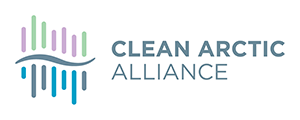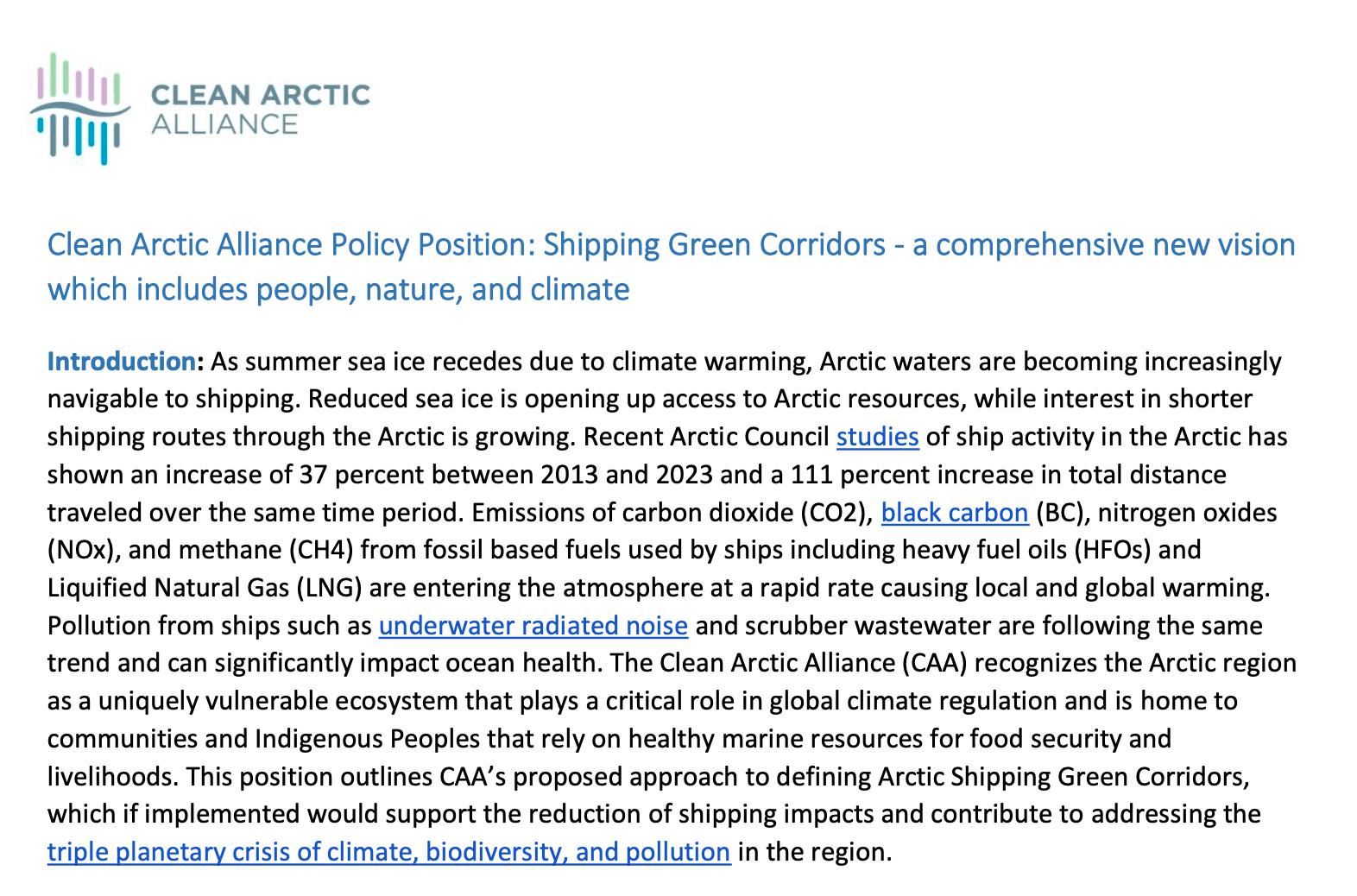Introduction: As summer sea ice recedes due to climate warming, Arctic waters are becoming increasingly navigable to shipping. Reduced sea ice is opening up access to Arctic resources, while interest in shorter shipping routes through the Arctic is growing. Recent Arctic Council studies of ship activity in the Arctic has shown an increase of 37 percent between 2013 and 2023 and a 111 percent increase in total distance traveled over the same time period. Emissions of carbon dioxide (CO2), black carbon (BC), nitrogen oxides (NOx), and methane (CH4) from fossil based fuels used by ships including heavy fuel oils (HFOs) and Liquified Natural Gas (LNG) are entering the atmosphere at a rapid rate causing local and global warming. Pollution from ships such as underwater radiated noise and scrubber wastewater are following the same trend and can significantly impact ocean health. The Clean Arctic Alliance (CAA) recognizes the Arctic region as a uniquely vulnerable ecosystem that plays a critical role in global climate regulation and is home to communities and Indigenous Peoples that rely on healthy marine resources for food security and livelihoods. This position outlines CAA’s proposed approach to defining Arctic Shipping Green Corridors, which if implemented would support the reduction of shipping impacts and contribute to addressing the triple planetary crisis of climate, biodiversity, and pollution in the region.
Arctic Biodiversity and Climate Green Shipping Corridors
The Clean Arctic Alliance believes that a more expansive policy approach should be adopted to address shipping at the intersection of climate, biodiversity and pollution. Up to this point, Green Corridors have primarily been siloed within the push for shipping decarbonization. The Clean Arctic Alliance recommends a strategic approach to addressing shipping’s contribution to climate heating, biodiversity loss and marine pollution in Green Corridors. Key elements of this new approach include:
- Decarbonization of Arctic Shipping: Decarbonization is one of the cornerstones of environmentally sustainable shipping. Energy efficiency measures across all vessel categories along with wind power should be deployed to meet short and longer term climate targets. Efficiency and wind will be key to meeting 2030 climate goals and should be prioritized, especially because they will minimize the need for all types of fuels, fossil, renewable or zero emission. The focus should be on scalable, zero emission fuel options which avoid blue and grey forms of energy such as hydrogen produced from fossil fuels, and bio and synthetic methane. LNG should explicitly be ruled out as an alternative fuel due to its high methane slip, community impacts from fracking, and lifecycle greenhouse gas emissions.
- Mitigation of biodiversity loss: Underwater radiated noise (URN) from shipping disrupts the communication and navigation of marine life, and interferes with reproduction and foraging for food. Ships have been identified as the top contributor of URN globally and can play a major role in quieting our oceans. Arctic green shipping corridors should recognize this fact and put in place noise budgets for marine areas and noise thresholds for all ship types. The goal of quiet ships is often achieved through speed reduction and the implementation of efficiency measures thus complementing decarbonisation efforts. Speed limits within green corridors should be prioritized and a focus on reducing propeller cavitation and overall ship efficiency should be incentivized. The increased interest in Arctic shipping heightens the risk of whale strikes. The Polar Code includes mandatory requirements for voyage planning and action in relation to marine mammals, Arctic green shipping corridors should include mandatory ship speed limits in marine mammal migration corridors, real-time location tracking systems, and routing measures to prevent collisions with marine wildlife.
- Reduction of Polluting Emissions: Black carbon has a significant impact on Arctic ice and snow melt, and contributes to local and global heating. It is 20% of the shipping sector’s global climate impact and is 5 times more potent when released in the Arctic. Reducing its emissions can reverse habitat loss, maintain food security for communities, and contribute to reaching climate targets. Arctic green shipping corridors must require ships to eliminate the use of HFO, switch to MGO with the use of a diesel particulate filter on route to decarbonisation, eliminate the installation and use of scrubbers, and implement efficiency measures to dial back fuel use. Scrubbers turn air pollution into ocean pollution and release harmful toxic chemicals and heavy metals into the ocean environment. Arctic green shipping corridors should include a total ban on the discharge of open and closed looped scrubber wastewater.
- Other Ship Pollution Sources:
- Sewage and greywater discharges from ships into the marine environment can contribute to lowering oxygen levels, spreading bacteria and viruses, introducing invasive species, and raising nutrient levels. The use of advanced wastewater treatment systems is paramount, along with strict no discharge zones and mandatory on board management planning to eliminate harmful products and chemicals from making it onto a ship in the first place.
- Shipping is responsible for 60 to 90% of the introduction of exotic species into new territories through hull fouling and ballast water. Arctic green shipping corridors must enforce strict ballast water management standards along with frequent testing and the mandatory application of the IMO’s hull fouling guidelines, which include regular hull inspections and cleaning to avoid fouling.
- Tanks, machinery, engine spaces and equipment are flushed and washed during routine operations at sea and in port. Residues as a result of these processes can contain hazardous chemicals, oils of all types, invasive species, and a wide variety of harmful compounds. A strict zero discharge and zero tolerance regime must be in place in all green shipping corridors to ensure limited impact to ocean health.
- Just and Equitable Transition in Shipping: The transition to a holistic and comprehensive approach must be just and equitable. Supporting Indigenous Peoples and coastal communities through this transition by ensuring access and funding to emerging renewable energy solutions, and that they are protected from economic and social hardship and dislocations must be central to the implementation of Arctic green shipping corridors. This includes participation in policy-making, access to training and education, and direct benefits from green shipping initiatives.
Conclusion: In the Arctic the Clean Arctic Alliance calls for a reframing of what has been considered a green corridor up to this point. An approach should now be in place which integrates addressing marine pollution and the biodiversity crisis together with the climate emergency. By focusing Arctic green shipping corridors in the intersection of these crises and identifying co-benefits which address both, rapid progress could be achieved in shipping’s response to the urgency of our times. This vision for a clean, sustainable, and equitable Arctic shipping sector is not only necessary for achieving climate targets but also for the prosperity of global and local communities dependent on the health of the global ocean.


